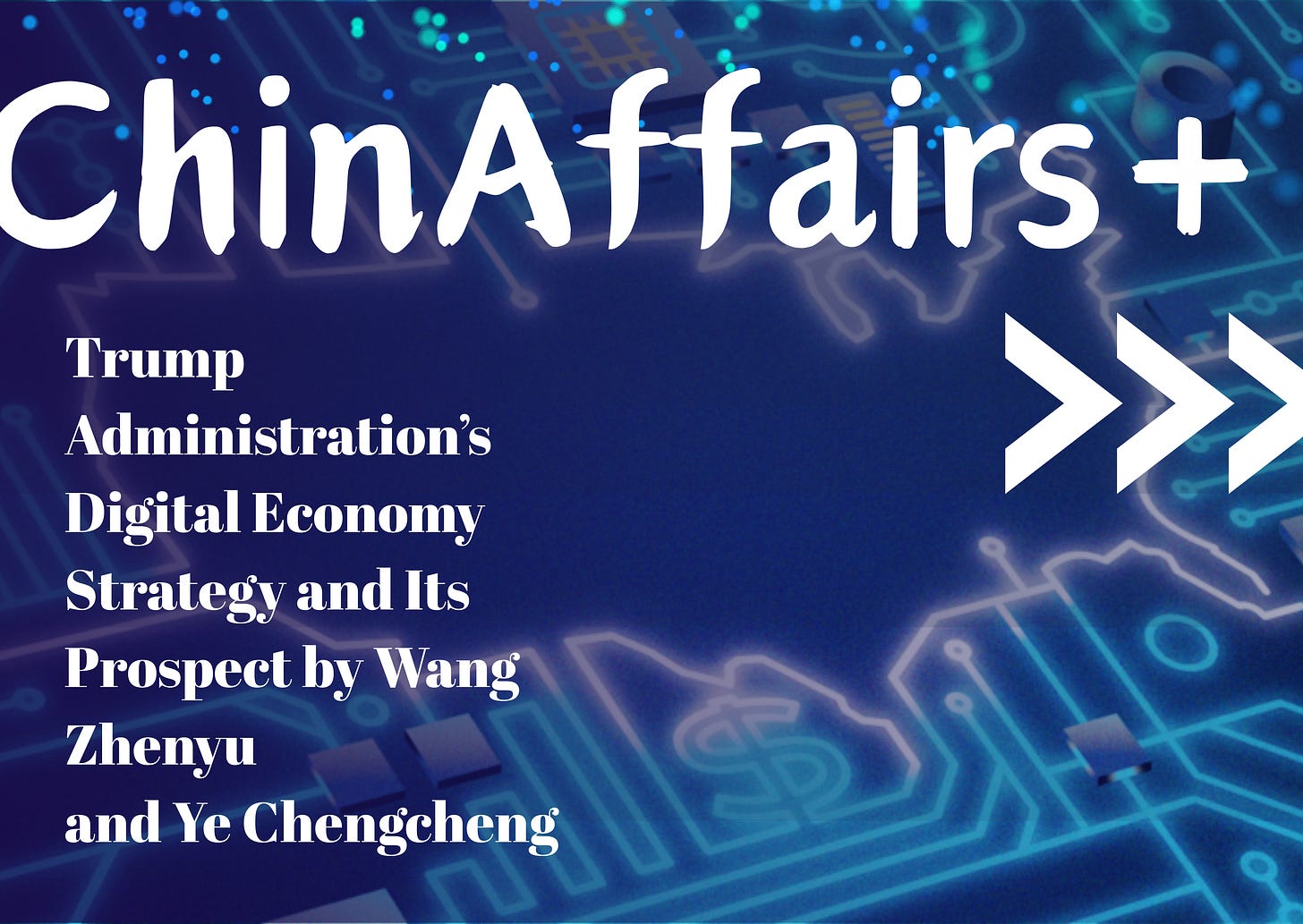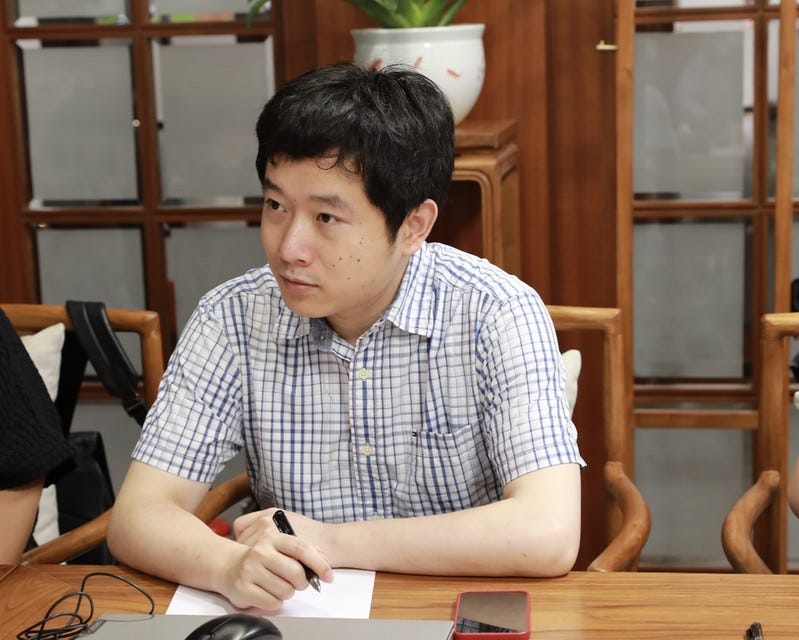The Trump Administration's Strategy for the Digital Economy and Its Prospects by WANG Zhenyu and YE Chengcheng
Understanding U.S. digital economy policy is key to navigating shifting global tech standards, market dynamics, and emerging governance risks.
Welcome to the 45th edition of our weekly newsletter! I'm SUN Chenghao, a fellow with the Center for International Security and Strategy (CISS) at Tsinghua University, Council Member of The Chinese Association of American Studies and a visiting scholar at the Paul Tsai China Center of Yale Law School (fall 2024).
ChinAffairsplus is a newsletter that shares articles by Chinese academics on topics such as China's foreign policy, China-U.S. relations, China-Europe relations, and more. This newsletter was co-founded by my research assistant, ZHANG Xueyu, and me.
Through carefully selected Chinese academic articles, we aim to provide you with key insights into the issues that China's academic and strategic communities are focused on. We will highlight why each article matters and the most important takeaways. Questions and feedback can be addressed to sch0625@gmail.com
Today, we have selected an article written by Wang Zhenyu and Ye Chengcheng, which focuses on the Trump administration's strategy for the digital economy and its prospects.
Summary
Since resuming office, the Trump administration has formulated an economic framework based on digital mercantilism, characterized by four key dimensions: implementing domestic deregulation and external containment in technology, promoting digital asset expansion in financial markets, adopting a tax reduction plus investment policy mix for industrial development, and coercing through tariffs in international relations. The strategy reflects the latest demands of Trump's core support groups for the development of the digital economy at the domestic and international levels. While potentially yielding short-term gains, the strategy's inherent contradictions may precipitate significant policy volatility during implementation. Such instability could exacerbate turbulence in global digital economic governance, creating systemic risks for international cooperation in this critical domain.
Why It Matters
Discussing the status and prospects of the U.S. digital economy policy holds significance for two key reasons. First, the digital economy has become a crucial engine for global economic growth, and as a leading force in digital technology and capital markets, the U.S. plays a decisive role in shaping global technology standards, data governance, and market regulation. Especially amid geopolitical tensions and intensifying digital technology competition, U.S. policy shifts—such as domestic deregulation, external technology restrictions, and expansion of digital assets—often rapidly transmit globally, reshaping international supply chains and competitive landscapes. Second, U.S. policies themselves exhibit high uncertainty, and frequent policy fluctuations may pose systemic risks to global digital governance. Therefore, in-depth analysis of the dynamic evolution of U.S. digital economic strategy helps better understand global digital economy trends and potential areas of contention, providing forward-looking insights for policymaking and business planning.
Key Points
1. Definition of the Digital Economy
The digital economy is generally defined as encompassing all economic activities that rely on digital inputs or are significantly enhanced by their use. It primarily includes digital technologies, digital services, and digital infrastructure—most notably information and communication technology (ICT) products and services. Its impact extends across and transforms all sectors of the economy, from science and technology to finance, industry, and energy.
2. Core Elements of the Trump Administration's Strategy for the U.S. Digital Economy
During his second term, the Trump administration has advanced a strategy for the digital economy grounded in his "America First" doctrine, blending unipolar hegemonic logic with mercantilist thinking. Centered on national security and global power competition, the strategy reinforces state intervention and regulation, integrates trade protectionism with digital geopolitics, and aims to suppress competitors while sustaining U.S. hegemony.
(1) Technological Domain: Deregulation Domestically, Tightened Control Externally
Trump's current technological policy prioritizes maintaining U.S. global leadership and favors reshaping market rules through policy tools over increasing public investment in science and education.
Domestically, Trump has significantly relaxed regulatory constraints on artificial intelligence (AI) development. Through the ‘Executive Order on Maintaining American Leadership in Artificial Intelligence’, he simplified approval processes and reduced compliance burdens to accelerate AI commercialization and support private-sector innovation. Future measures may include increased R&D and infrastructure investment, alongside a more permissive legal framework for AI.
Towards China, Trump has intensified technological containment and control over technology diffusion. Central to this effort is export control, supplemented by entity list restrictions and pressure on allied suppliers, all intended to raise barriers to China's access to advanced manufacturing technologies. Pursuant to two presidential memoranda and the America First Trade Policy, the U.S. is expected to impose stricter trade and investment restrictions on China, while promoting mechanisms such as "fast-track approval" and "trusted partner" frameworks to coerce international capital into choosing sides.
(2) Financial Sector: Shaping Favorable Expectations for Digital Assets and Expanding Dollar Hegemony through Digital Currency
The Trump administration explicitly positions digital assets as a strategic pillar of U.S. innovation, economic development, and global leadership. It seeks to consolidate dollar hegemony through the creation of strategic digital asset reserves and the promotion of U.S. dollar-backed stablecoins.
Deregulation and Strategic Reserve Formation via Executive Orders
On taking office, Trump signed the Executive Order on Strengthening U.S. Leadership in Digital Financial Technologies, which repealed the Biden-era regulatory framework for digital assets. Instead, it emphasizes protection and promotion of innovation and application within the digital asset sector. Additionally, at the White House Digital Asset Summit on March 16, 2025, Trump signed an executive order establishing strategic reserves in Bitcoin and other digital assets.
Creation of a Presidential Task Force on Digital Asset Markets
A dedicated task force has been established within the National Economic Council to support the development and oversight of the digital asset industry. Through interagency coordination, the administration aims to formulate a clear, transparent, and inclusive regulatory framework that further integrates digital assets with U.S. sovereign credit.
Support for Global Expansion of Dollar-Backed Stablecoins
The Trump administration actively promotes stablecoins pegged to the U.S. dollar and led by private sector actors. It has explicitly banned the development or promotion of central bank digital currencies (CBDCs) by any domestic or foreign entity. This policy is expected to continue, aiming to delay monetary internationalization by competitors while removing political barriers to expanding stablecoins on a global scale.
(3) Industrial Sector: Protecting National Champions and Re-shoring Manufacturing
The Trump administration is advancing a "tax reduction + investment" policy mix to protect national champion enterprises and encourage the re-shoring of manufacturing, thereby revitalizing U.S. digital industry development.
Reducing the Tax Burden on U.S. Digital Firms
Tax cuts are a central pillar of Trump's economic agenda. The administration has pursued the Global Tax Deal, signed the Executive Order on Protecting American Companies and Innovators from Foreign Extortion and Unfair Fines and Penalties, and relaunched Section 301 investigations to counter foreign digital service taxes. It has also supported international expansion of national champions by suspending enforcement of the Foreign Corrupt Practices Act. Looking ahead, the Trump administration may extend or even make permanent the Tax Cuts and Jobs Act, while introducing further tax incentives for digital hardware production to draw manufacturing back to the U.S.
Concentrated Investment in Digital Infrastructure
Through the America First Investment Policy and the implementation of the "Stargate" digital infrastructure initiative, the Trump administration seeks to mobilize targeted investments from strategic allies and the private sector into key digital industries. This model—tied to state-backed policy commitments—is expected to become a primary vehicle for attracting foreign direct investment into the U.S. digital economy.
(4) International Arena: Dual Strategy of Tariff Pressure and Geopolitical Coercion
Trump views strengthening domestic advantages and reducing foreign dependencies as the core mandate of the "America First" doctrine. His administration pursues a dual-track strategy—applying tariff pressure to gain competitive leverage and employing geopolitical coercion to control critical resources.
Using Tariffs to Undermine Competitors, Including Allies
The Trump administration has employed aggressive tariff policies to suppress digital industry rivals, while pressuring foreign governments to relax regulations on U.S. digital firms. In pursuit of safeguarding the American semiconductor industry and reducing reliance on Asian supply chains, Trump is likely to further increase semiconductor tariffs, particularly targeting the European Union, which has opposed such U.S. measures.
Seeking Control of Critical Resources through Expansionist Policies
As minerals and energy become increasingly essential for AI applications and data center expansion, the administration has sought to exert geopolitical pressure on countries such as Ukraine and Canada. Tools include joint management via investment funds, suspension of military aid, coercive control over maritime routes, and even territorial acquisition efforts—aimed at strengthening U.S. dominance over key resource reserves and supply chain nodes.
3. Origins of the Trump Administration's Strategy for the Digital Economy
The Trump administration's strategy digital economy is shaped by a dual logic of domestic politics and foreign policy—rooted both in the demands of core voter blocs and in a revisionist perception of the international system.
(1) Domestic Drivers: Concentrated Discontent Among the Republican Party's Two Core Constituencies
The Republican base in the 2024 election comprises two main groups—elites and working-class voters. The former criticize the Democratic Party for excessive regulation of the tech sector, arguing that such intervention undermines U.S. global competitiveness and national security. The latter oppose progressive policies and high-tax welfare programs, viewing them as detrimental to economic growth and inattentive to labor interests. Following Trump's return to office, representatives of these groups—such as Elon Musk and Vice President J.D. Vance—assumed key roles in digital policy-making. They have shaped a new trajectory centered on deregulation, the promotion innovation, tax cuts, and reassertion of trade and energy sovereignty, thereby responding to the concrete demands of Silicon Valley conservatives, blue-collar workers, and industrial capitalists.
(2) Foreign Policy Drivers: Correcting Democratic Internationalism by Establishing U.S.-Led Digital Unilateralism
In foreign affairs, the Trump administration's neoconservative ideology rejects the current liberal international order, contending that global regulatory and taxation regimes unfairly disadvantage the U.S. digital economy. It expresses strong discontent with the economic practices of the Democratic administration and traditional allies such as the EU and Canada. Consequently, Trump's team embraces a "digital mercantilist" strategy—willing to harm allied interests and apply tariff coercion—to pursue a unilateralist vision of a U.S.-dominated digital economy marked by full-spectrum leadership and strategic self-sufficiency.
4. Prospects for the Trump Administration's Digital Economy Strategy
The Trump administration's digital economy strategy—an integrated policy package spanning technology, finance, industry, and foreign affairs—aims to establish a unipolar digital ecosystem in which the United States controls critical resources and pioneers technological development. While favorable domestic conditions and personnel advantages may support its implementation, the strategy faces substantial external constraints, creating a paradox of potential success constrained by intrinsic limitations.
(1) Technology: Innovation and Commercialization may Succeed, but Has Consequences for International Innovation
On one hand, incorporating tech elites into senior government roles strengthens public–private collaboration, particularly with Silicon Valley, fostering a more permissive environment for frontier technologies such as AI. This could accelerate innovation and commercialization. However, excessive deregulation may lead to the misuse of technology, erode public trust, and introduce systemic risks.
On the other hand, intensified U.S. intervention in global digital activities—especially aimed at containing China—could spill over into international investment and scientific cooperation, forcing allies and other nations to take sides. This fragmentation of the global tech ecosystem undermines the collaborative foundation of technological progress and may ultimately weaken U.S. leadership in global science and innovation.
(2) Finance: Strong Support for Digital Assets, but Stablecoins Unlikely to Sustain Dollar Hegemony
Given America's structural advantages in global finance and capital markets, state endorsement of digital assets will likely boost crypto market valuations. If successful, Trump's digital finance strategy could reshape global regulatory norms and consolidate U.S. financial leadership. However, the high volatility of cryptocurrencies renders them unsuitable as strategic reserves and may introduce instability into the international financial system. Moreover, with 134 countries and currency blocs exploring Central Bank Digital Currencies (CBDCs), the U.S.'s unilateral promotion of private-sector stablecoins is likely to conflict with divergent global regulatory norms, exacerbating tensions in international financial governance.
(3) Industry: Tax Cuts Are Achievable, but Investment Bubbles Pose Risks
Trump's industrial strategy—centered on tax cuts and targeted investment—is likely to stimulate short-term profit and job growth, especially in digital manufacturing. Nevertheless, his ambitious promises of a large-scale reshoring in manufacturing may prove unsustainable and bubble-prone, as exemplified by the failed Foxconn project in Wisconsin. Macroeconomic headwinds such as high interest rates, inflation, sovereign debt, and trade uncertainty will further constrain investor confidence and challenge the fiscal viability of large-scale industrial initiatives.
(4) International Affairs: Tariff Pressure and Geopolitical Coercion Likely to Falter
Trump's reliance on tariffs and geopolitical coercion is unlikely to restructure global supply chains; instead, it incentivizes "hedging" strategies among firms and raises domestic production costs. His expansionist agenda has fueled anti-American sentiment and hindered efforts to secure critical resources. This approach erodes international institutional trust, intensifies global polarization, and injects volatility into the governance of the digital economy.
To sum up, the fundamental dilemma of Trump's digital economy strategy lies in its attempt to simultaneously satisfy the conflicting demands of Silicon Valley libertarians, blue-collar workers, and industrial capitalists—an irreconcilable "strategic trilemma" of financial globalization, domestic reindustrialization, and digital unipolarity. Financial globalization depends on open markets and talent flows, which undermine labor interests; reindustrialization requires the kind of state intervention that contradicts free-market innovation; and unilateralism fails to reconcile the two. As a result, the strategy risks devolving into "opportunistic mercantilism," prioritizing short-term capital gains at the expense of long-term competitiveness and policy coherence.
Conclusion
Trump's digital economy strategy seeks to reinforce U.S. hegemony through an expansive and centralized model of "digital mercantilism." However, it faces deep-seated tensions across economic, political, and diplomatic dimensions. Economically, it combines laissez-faire deregulation with state intervention, creating inherent policy contradictions. Politically, its attempt to reconcile conflicting domestic interests risks exacerbating social polarization and weakening governance capacity. Diplomatically, its "winner-takes-all" digital unipolarity undermines international consensus and strains alliances. These structural incompatibilities are likely to produce strategic inconsistency and global digital instability. In response, China should uphold a vision of mutual benefit and advance an open, inclusive digital governance framework.
About the Author
Wang Zhenyu 王震宇: Wang Zhenyu is an Assistant Research Fellow at the Shanghai Academy of Social Sciences. He received his Ph.D. in Journalism from Fudan University. His research focuses on digital political economy, computational social science, and public-opinion studies. Dr. Wang also serves as an Adjunct Research Fellow at the State Innovative Institute for Journalism & Communication Studies and Media Society at Fudan University and is a member of the Professional Committee of Social Computing and Social Intelligence (Chinese Association for Artificial Intelligence, CAAI).
Ye Chengcheng 叶成城: Ye Chengcheng is an Associate Research Fellow at the Institute of International Relations at the Shanghai Academy of Social Sciences. Dr. Ye holds a Ph.D. in Economics and has completed post-doctoral research in Political Science. His research interests center on scientific methodology, comparative modernization, geopolitics, and related fields.
About the Publication
The Chinese version of the article is published by The Journal of World Economy《世界经济》. The Journal of World Economy is a monthly journal and the official publication of the Institute of World Economics and Politics, part of the Chinese Academy of Social Sciences, a major think tank in China, and the Chinese Association of World Economy, the premier academic organization in China devoted to the study and promotion of knowledge about international economic issues. The Journal of World Economy is one of the leading economic journals and one of the most widely cited journals in all of economics as well as in China. Its special emphasis is on theoretical and empirical research in all areas of international economics. Areas of interest include international trade, international finance, open economy macroeconomics, regional studies and international political economy. The journal also covers related areas such as the Chinese economy, development economics, and capital markets. It's a vital resource for researchers, analysts and policy-advisors on open economy issues, and also an essential reference for in-depth knowledge on and up-to-date coverage of international economic relations.












